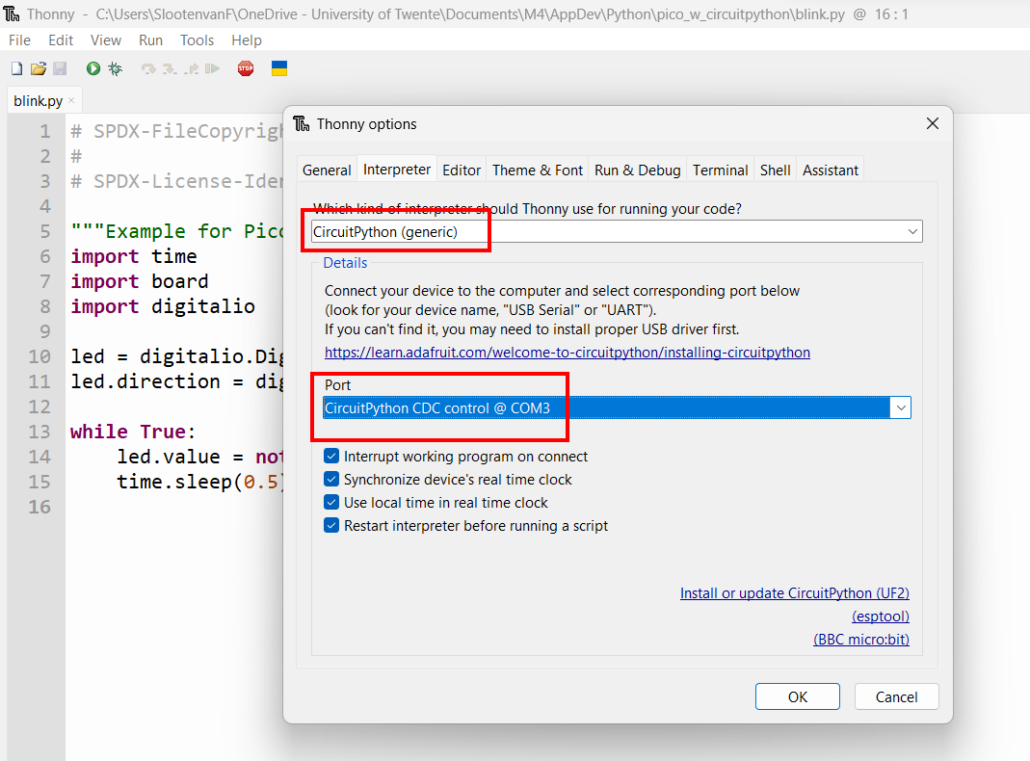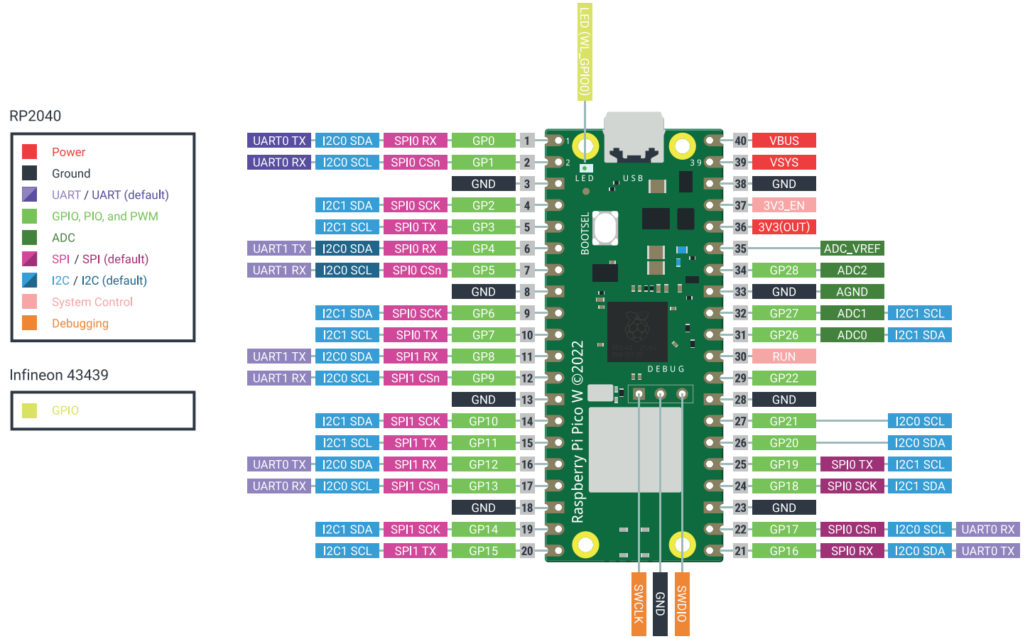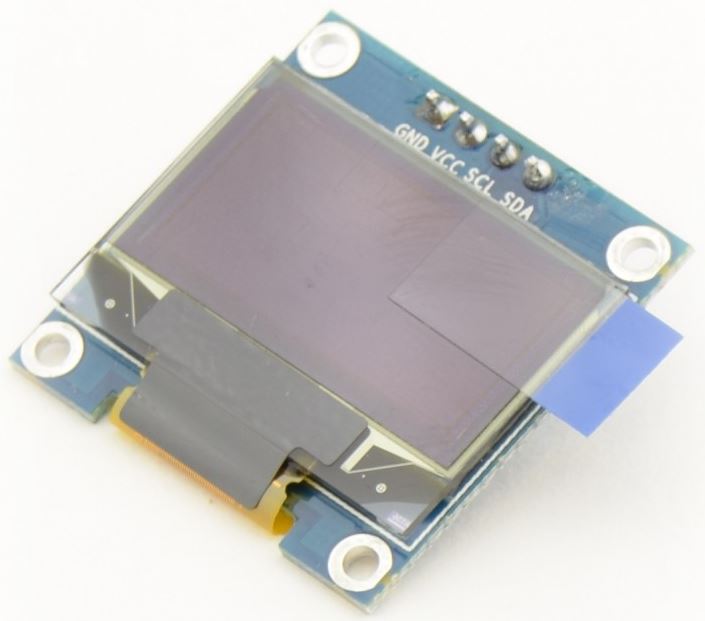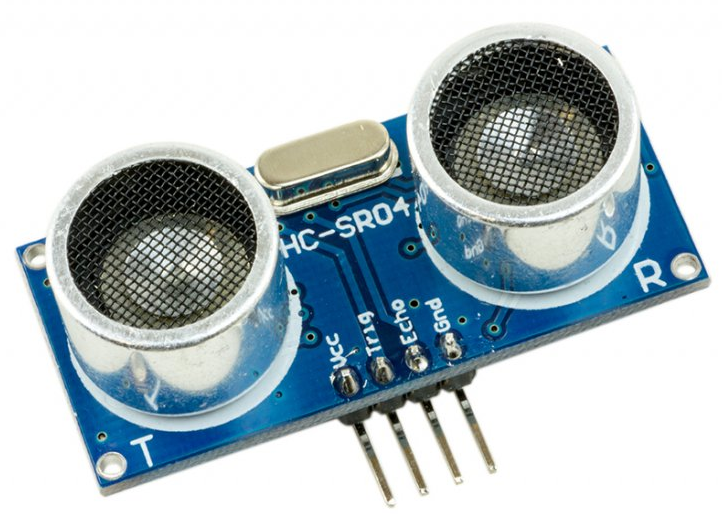In a previous tutorial “build a distance sensor with an alarm” we used an Arduino Nano (coded in a C-variant). Now, we will do the same with a Raspberry Pi Pico and CircuitPython, a version of Python which runs on microcontrollers. If you are more interested in programming the Pico with the Arduino IDE (in C), check out this tutorial.
A simulation in Wokwi is availabe here:
- CircuitPython version (detailed below)
- MicroPython version (based on this tutorial)
In this tutorial you will learn to build a distance sensor with an alarm. Starting with basic steps to connect electronic components and programming the Raspberry Pi Pico in Python. Then, connect an ultrasonic distance sensor to sense the distance to an object nearby and show the measured value on an OLDED display.
It consist of the following steps:
- Setup the Raspberry Pi Pico
- Connect and test the OLED display
- Connect and test the Ultrasonic sensor
- Add an alarm depending on the distance
- Add comments to the code
What you need
- Breadboard, wires, micro USB cable
- Raspberry Pi Pico
- An OLED display, eg. this 0.96 inch OLED Display (128*64 pixels)
- A distance sensor, eg. HC-SR04 Ultrasonic sensor
- A buzzer
1. Setup the Raspberry Pi Pico
First, install the latest version of CircuitPython to the board:
Download the .UF2 file for the Pico here (make sure to pick the right version of the board: my students will probably have a Pico W or Pico 2 W). Connect the USB-cable to the board. While pressing the BOOTSEL button on the board, connect the other end of the cable to your computer. Continue to hold the BOOTSEL button until a drive appears: a new drive labelled ‘RP…’ will appear in your Windows Explorer (or Finder on a Mac). In the example this is the D: drive, but it might be different on your computer:

Now drag the downloaded .UF2 file to the RPI-RP2 drive. Now wait for the drive to disappear and then re-appear (labelled CIRCUITPY).
For more detailed steps check out the tutorial “Installing CircuitPython”.
Check the Raspberry Pi Pico, blink the onboard LED
To start writing code, you need an editor. We use Thonny in this tutorial. So, download and install that. Or use Visual Studio Code if you prefer that:
Note on Visual Studio Code
Be aware that in order to use CircuitPython in Visual Studio Code, you must install the CircuitPython extension and read the getting started guide for using the CircuitPython extension with Visual Studio Code.
After you have installed and setup the editor, you can create your first Python file. Select File > New. And copy-paste the code below into the editor.
# SPDX-FileCopyrightText: 2021 Kattni Rembor for Adafruit Industries
#
# SPDX-License-Identifier: MIT
"""Example for Pico. Blinks the built-in LED."""
import time
import board
import digitalio
led = digitalio.DigitalInOut(board.LED)
led.direction = digitalio.Direction.OUTPUT
while True:
led.value = not led.value
time.sleep(0.5)
This code comes from the first part of this tutorial, at “The LED blinks!”. If you want to learn more of how exactly it works follow the steps in that tutorial!
The first lines start by importing several modules using the import statement. A module is a set of code which can be reused easily. It contains code to avoid you having to ‘re-invent the wheel’ all the time.
Before you can run the script, first connect the Raspberry Pi Pico board to your computer using a USB cable (do not mount it on a breadboard yet). Wait a few seconds to let it initialize. Then, in the Thonny editor, choose Run > Configure interpreter and set the interpreter to CircuitPython and choose the active port (in Windows: the one that has CircuitPython CDC control…):

Close the Options Window (Press Ok). Now, you should be able to run the script. Press Run ![]() and see what happens… If all is well, the LED next to the USB connector on the board should start blinking.
and see what happens… If all is well, the LED next to the USB connector on the board should start blinking.

2. Connect and test the OLED display
The 0.96 inch OLED Display (128*64 pixels) is an i2c module, which makes it easy to connect as it has only 4 wires. It is assumed you have some basic understanding of using electronics and wiring a breadboard. For making the right connections you need the pinout diagram of the Pico:

See the image below. Pins of the display are on the board itself. Please take great care: pins on your display might be in a different order! The one below has GND-VCC-SCL-SDA, but yours might be different! You can also run a simulation of the circuit here and take a closer look at the wiring.

Unplug the USB cable. Plug the Pico onto the breadboard. Start wiring the power lines (blue and red lines on the breadboard) to GND, 3V3 and 5V (VBUS) of the Pico:

Then plug the display onto the board and wire it:
Display: Pico: Wire color in diagram:
GND GND black
VCC 3V3 red
SCL pin 5 (I2C1 SCL/GP3) yellow
SDA pin 4 (I2C1 SDA/GP2) blue
(you are free to choose any other color for the wires)
Download example code
To test the display, you can use this example script: display.py. Open it in the editor. Please be aware that the script is saved in your Download folder. If you do not want this, Select File > Save As to save it to another folder, for instance the Documents\Python folder.
After you double check the wiring from the previous step, plug in the USB cable.
Before you can run the example, you must install some CircuitPython libraries used by it. Go to circuitpython.org/libraries and scroll down to the “Bundles” section. Download the latest bundle for your version of CircuitPython (assume that is version 9, the same as you installed in step 1!). Extract that zip-file and copy the folders and files below (they are in the lib folder of the zip-file) to the lib folder of the drive (eg. D:\lib) on the Raspberry Pi Pico:
folders:
adafruit_bitmap_font
adafruit_bus_device
adafruit_display_text
files:
adafruit_displayio_ssd1306.mpy
adafruit_ssd1306.mpy
adafruit_hcsr04.mpy
The last one, adafruit_hcsr04.mpy, is used in the next section.
Press Run ![]() and check if “Hello World!” is shown on the display.
and check if “Hello World!” is shown on the display.
You can also run a simulation of this circuit here and take a closer look at the wiring.
3. Connect and test the Ultrasonic sensor
This part of this tutorial introduces the HC-SR04 Ultrasonic sensor. Most (older) versions of this sensor need 5V power to operate properly and also work on a 5V logic level. For this, we will connect the Ultrasonic sensor to 5V (via the VBUS pin on the Pico) and add a voltage divider for the Echo pin, because the logic level of the pins on the Pico is 3.3V. If you can use a more modern version of the sensor, like the RCWL-1604, then the voltage divider is not needed and you can simply power the sensor with 3.3V.
Disconnect the USB cable before you continue.

To use this sensor, you can connect it to power (GND and 5V/VBUS) and connect the Echo and Trig pins to pin 21 and 22 of the Pico:
Sensor: Pico: Wire color:
Gnd GND black
Vcc 5V (VBUS) red
Echo pin 21 (GP16) magenta
Trig pin 22 (GP17) cyanFor the voltage divider, use two 10k resistors (brown-black-orange).

The result should look like below:

To test the sensor, you can use this example script: display_distance.py. Open it in the editor and save it to your documents folder.
After you double check the wiring from the previous step, plug in the USB cable. Press Run ![]() and check if measured values of the distance measured are shown on the display.
and check if measured values of the distance measured are shown on the display.
You can also run a simulation of this circuit here and take a closer look at the wiring (learn more about simulating electronic circuits here).
The values are displayed with 3 decimals, which is unnecessary. Try to round the value using round(…)
Please note that if you want to run the Pico powered by an alternate power source (not linked to your computer), you must name the script main.py and upload it in the main folder on the Pico itself. (main.py is the script that will be automatically run when the Pico gets power). More info.
4. Add an alarm depending on the distance

We are going to use a buzzer, which is a small device that can generate tones. There are different types, as explained here.
Function wise they all work the same: a Pulse-Width-Modulated (PWM) signal is sent to it to generate the sound. Usually, the + pin of the buzzer is indicated by a + sign on the housing or on the bottom. If it is not, the longest leg is the +. If there is no visible indication of a + pin, just connect it. You cannot break it by connecting it wrong, just give it a try. If it does not work, reverse the connection and try again.
Connect the + pin of the buzzer to pin 20 (GP15) of the Pico (scroll up for pinout diagram) and connect the other pin to the (blue) GND track of the breadboard.
Next, start a new file in the editor and copy the code below into it.
import time
import board
import digitalio
import pwmio
buzzer = pwmio.PWMOut(board.GP15, frequency=660, duty_cycle=0, variable_frequency=True)
while True:
buzzer.duty_cycle = 2 ** 15
time.sleep(0.5)
buzzer.duty_cycle = 0
time.sleep(0.5)
Connect the USB cable, press Run ![]() and the buzzer should start beeping.
and the buzzer should start beeping.
If you are already an experienced programmer, you should be able to combine the previous example (from step 3) with this one and make an alarm dependent on how close an object is. But combining two scripts might be a bit much for a start, so we have done this for you. The only thing we left out is the part which determines when the alarm has to sound. (This will be an if statement with a call to a function).
The combined example can be downloaded here: ultrasonic_sensor_warning.py. Browse through the code, and check for parts you recognize from the previous examples. Try the example (upload it). As you may notice, it beeps shortly at the start. Can you find the lines of code which do this? This is the part:
def beep():
buzzer.duty_cycle = 2 ** 15
time.sleep(0.5)
buzzer.duty_cycle = 0
time.sleep(0.5)
# beep two times:
for x in range(2):
beep()To make an alarm, two things have to be done:
- Determine if an alarm has to be sound (with a condition)
- Make the alarm sound
Determine if an alarm has to be sound (with a condition)
In the while-loop at the end, find this line of comment:
# something nearby?After that line, add an if-statement, with the next line of comment inside it:
if condition:
# sound alarmIf something is close, the variable distance is smaller than a certain value. So an example of the condition is distance < 100. Add this to the code (replace the condition of the if-statement).
Make the alarm sound
Inside the if-statement, add the line of code which makes a beep (look at the code before the while-loop for an example): what you must add is a call to the beep() function.
Now test the script (upload it). Does it work? Adjust the distance checked for in the condition. It should NOT be a meter (100cm) but a closer distance.
5. Add comments to the code
Add more comments to the part of the code that you added/modified. The comments should explain, in your own words, what this code does. Use multi line comments or single line comments. Some examples:
"""
Example of a multi line comment.
This is the second line of the comment.
"""
# Example of a line of code with comment at the end of the line:
print("Start of distance measurement") # display text on standard output
At the top of the script, add general comments. The first line of comments should contain your name and student number. Add at least one more line which explains the general meaning of the script as a whole (what does it do?).
Summary
With this tutorial you have familiarized yourself with building an electronic circuit using a breadboard and you have used an editor to program the Raspberry Pi Pico with a script.
In addition, you have learned the following:
- Adding components like a display and a sensor to a breadboard and wiring them
- Using an example script to test the components
- Use and setup modules
- Add code to an existing script
- Explain and document code by adding comments to code
More information
- More Raspberry Pi Projects, Tutorials and Guides
- Interfacing HC-SR04 Ultrasonic Sensor with Raspberry Pi Pico (with voltage divider)
- Programming Raspberry Pi Pico with Arduino IDE (Pico W compatible)

